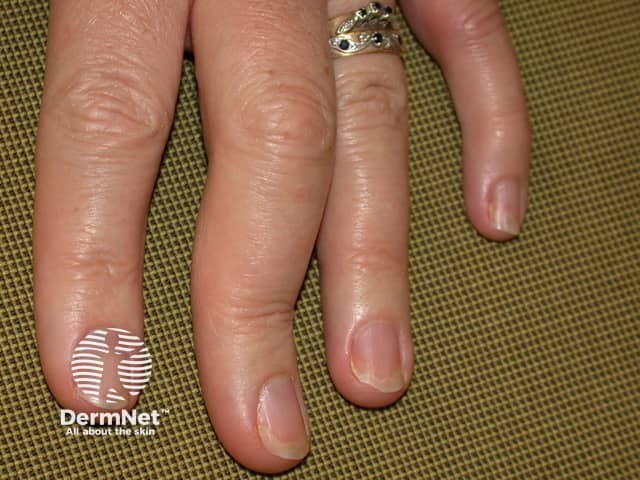Main menu
Common skin conditions

NEWS
Join DermNet PRO
Read more
Quick links
Dactylitis — extra information
Dactylitis
Author: Vanessa Ngan, Staff Writer, 2007. Updated by Dr Douglas White, Rheumatologist, Hamilton, New Zealand, November 2017.
What is dactylitis?
Dactylitis is inflammation of a digit (either finger or toe) and is derived from the Greek word dactylos meaning finger. The affected fingers and toes swell up into a sausage shape and can become painful.
Dactylitis due to psoriasis

Psoriatic arthritis

Psoriatic arthritis

Psoriatic dactylitis
What causes dactylitis?
Dactylitis is a feature of the conditions listed below.
Infection
Blistering distal dactylitis
- Superficial infection of the anterior fat pad of the distal portion of the finger(s)
- Most often occurs in children.
- Most commonly caused by group A beta-haemolytic streptococcus but also may be due to Staphylococcus aureus.
Tuberculous dactylitis
- A rare manifestation of extra-pulmonary tuberculosis
- A variant of tuberculous osteomyelitis affecting the short tubular bones of the hands and feet.
- Radiological findings show a central, lytic, cystic, and expansive lesion known as spina ventosa.
Syphilitic dactylitis
- A manifestation of congenital syphilis.
- Similar features as tuberculous dactylitis but involvement is bilateral and symmetrical.
Spondyloarthritis
- Dactylitis is a common feature in all forms of spondyloarthropathy, including psoriatic arthritis, reactive arthritis and ankylosing spondylitis.
- Dactylitis occurs in about one-third of patients with psoriatic arthritis, with the feet being most affected.
- Dactylitis is a marker of disease severity in psoriatic arthritis.
Gout
- Dactylitis can be found in up to 5% of people with gout, arthritis due to deposition of urate crystals.
Sarcoidosis
- Occurs in about 0.2% of patients with sarcoidosis, and often associated with lupus pernio (large bluish-red and dusky purple infiltrated nodules and plaque-like lesions on nose, cheeks, ears, fingers and toes).
- Bone and soft tissue involvement of the fingers classically presents as bilateral, fusiform or sausage-shaped swellings.
Sickle-cell dactylitis
- Also known as hand-foot syndrome
- Occurs in patients with sickle-cell anaemia, most frequently for the first time within the first four years of life
- In many cases, dactylitis is the first sign of the presence of the blood disorder and often leads to the diagnosis of sickle-cell disease.
- Sickle-cell dactylitis is often mistaken for other diseases, especially acute osteomyelitis, cellulitis, leukaemia, and rheumatic fever.
Importantly, dactylitis is not considered a typical feature of rheumatoid arthritis or osteoarthritis.
What are the clinical features of dactylitis?
In adults, dactylitis is frequently part of a systemic inflammatory condition. Other joints and areas may be affected. The inflamed digit is usually swollen and painful with consequently reduced function.
In children with sickle-cell disease, the first sign is usually quite sudden and is characterised by painful swelling of the hands, feet, or both. The child refuses to bear weight and has puffy, tender and warm fingers and toes. Symptoms are often accompanied by fever, raised white cell count and mild anaemia.
What is the treatment of dactylitis?
Dactylitis caused by infectious agents can be treated with appropriate antibiotics.
The clinical symptoms in sickle-cell dactylitis are self-limiting. Swelling and pain usually subside spontaneously without any medical or surgical treatment. The duration of symptoms may range from several days to a month. It rarely causes permanent damage but in some cases may result in shortening of the fingers as a result of premature fusion of the epiphyseal plates.
In other types of dactylitis, treating the cause is the main form of therapy. Treatment may involve immunosuppressive medications, or in gout, treatment to reduce serum uric acid. Non-steroidal anti-inflammatory medications and local injections of corticosteroid may help with symptom control.
References
- Brockbank JE, Stein M, Schentag CT, et al. Dactylitis in psoriatic arthritis: a marker for disease severity? Ann Rheum Dis 2005; 64(2): 188–90. Journal
- Jadavji T, Prober CG. Dactylitis in a child with sickle cell trait. Can Med Assoc J 1985; 132: 814-815. PubMed Central
- Olivieri E, Scarano A, Padula V, et al. Dactylitis, a term for different digit diseases. Scandinavian Journal of Rheumatology 2006; 35(5): 333–40. Journal
- Worrall VT, Butera V. Sickle-Cell Dactylitis. J Bone Joint Surg (Am) 1976; 58:1161-1163. PubMed
- Rothschild BM, Pingitore C, Eaton M. Dactylitis: implications for clinical practice, Semin Arthritis Rheum. 1998 Aug;28(1):41–7. PubMed
On DermNet
